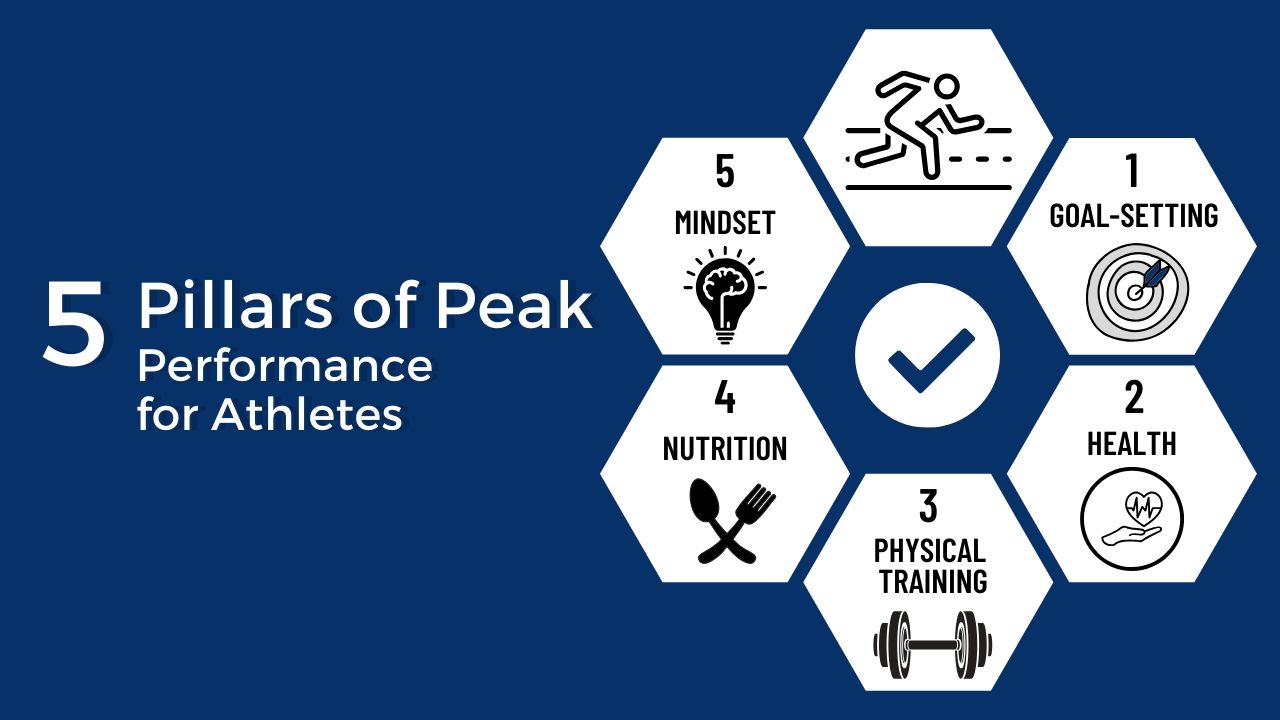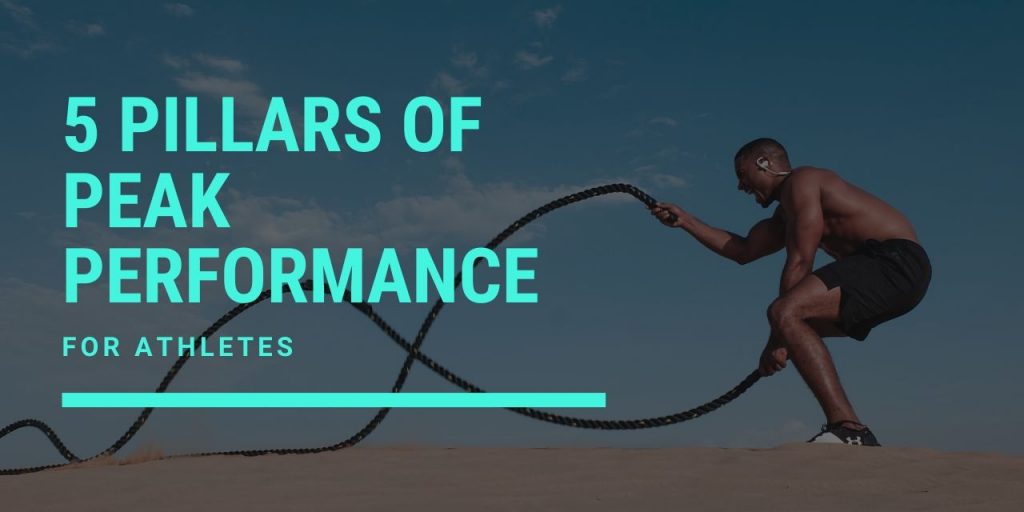In a time where accessibility to sports entertainment is at its greatest, we are blessed to see the absolute peak performances of many athletes. Whether it’s Lebron James’s ever-lasting dominance. Or perhaps Khabib Nurmagomedov’s unfathomable 28 MMA win streak. These phenoms represent some of the world’s most dedicated and talented superstars.
And no, peak performance is not exclusive to these athletic phenoms. College sports, firemen, farmers etc., are all groups of individuals who need to perform at their highest possible athletic level. Peak performance is relative to yourself. Every athlete has the capacity to become the best versions of themselves.
Careful planning is required to achieve peak performance. As a physical therapist who regularly works with athletes, we have a 5-step process to help unleash your full potential. By using renowned athletes as examples below, I will detail the 5 essential pillars needed to attain you peak athletic performance.

Goal-Setting
Setting your goals and priorities should be the first step. Peak performance has different meaning for each athlete. Maybe you’re a marathon runner who wants to break the coveted 2-hour mark. Or maybe your end goal is to dunk a basketball. Choose a clear and distinct goal that is meaningful for yourself. Your definition of ‘peak performance’ will be governed by these principles.
Once you have an end goal, it’s important to break that down into short goals. Think of them as taking steps towards the end of the staircase. Your end goal is to reach the end of the platform, but without physically conquering each individual step, this wouldn’t be a possibility. To optimise your goal-setting, I would encourage you to read this 6-step essential guide.
Take Conor McGregor for example, an athlete synonymous with the definition of peak performance in the UFC. He was the first in the UFC to hold 2 belts simultaneously and arguably one of the best MMA fighters ever. Visualising his goals was a big reason why McGregor was able to pioneer this feat. By watching this clip, McGregor clearly outlines goals before executing it in UFC 205 after beating Eddie Alvarez.
“ I want the lightweight belt and featherweight belt, that’s my goal.” – Conor McGregor
Goal setting not only drives convictions but also encourages structure and clear planning. Navigating your journey becomes much clearer with a destination. Defining your goals sets the precedence of identifying what peak performance means to you.
Health
Talent. Hard work. Mental toughness. All very crucial characteristics seen in champions and those who perform at peak athletic levels. With the right combination of attributes, any athlete can be unstoppable… until injuries happen.
Injuries are one of the biggest obstacles which athletes can encounter to achieving greatness. Take Derrick Rose for example, who at the age of 22, was the youngest NBA player to ever when a regular season MVP. A Chicago legend who epitomised peak athletic performance. His future looked bright, until his fateful ACL injury in the 2012 post-season. Despite continuing his productive NBA career, he has never looked the same since.
At the complete end of the spectrum, we have the legendary Lebron James. Someone whose career has been peaking eternally. At age 35 Lebron is still a leading MVP and championship candidate. So, what separates Lebron from Rose? Although there is no definitive answer, longevity is one of them. In 2016, Lebron spent 1.5 million dollars on maintaining his body. By working with recovery experts, Lebron has been able to peak consistently by minimising his injuries.
Although some might attribute this to luck, the proof is in the pudding. Only by keeping healthy, can one truly achieve peak athletic performance. By seeking out the right healthcare professionals such as physical therapists and sports physicians, not only can injuries be managed but also prevented. Anecdotally, most sporting injuries start out with just a ‘niggle.’ So if you are not 100%, seek an expert opinion promptly.
Also, don’t forget to sleep at least 7-8 hours/day. A big part of preventing injury and recovery is getting sufficient sleep. Dr. Matthew Walker has an excellent book detailing the importance of sleep and how optimal sleep patterns can be achieved.
Physical Training
This pillar is the most undeniable quality for achieving peak performance. What’s the one cliché that athlete champions almost always spout? ‘Hard work and dedication.’ There’s no way around it. One of the reasons NBA legend Kobe Bryant solidified his mythical status was his immense work ethic. Also known as Mamba Mentality as we all grew to embrace. Nothing can substitute the fruits of labour from optimal physical training.
However, ‘hard work and dedication’ alone is not enough. Purposeful and specific training is required to achieve greatness. This is where goal setting becomes so crucial. By having short-term and long-term goals, context can be provided how training should be approached. Look at Roger Federer, one of the greatest tennis players of all time. In the video below, we see Federer identify that his backhand’s weaknesses and how he purposefully trained to improve it. Whilst training, keep recognising why the drills are being performed and what else should be done.
Strategically planning your physical regime is so vital. How much is training is enough? How do I prevent overtraining? There is no single answer because… “peak performance has different meaning for each athlete”. Training needs to be contextualised. One important consideration is the FITT-VP principle which stands for frequency, intensity, time, type, volume and progression. All very important factors to cater for. Although self-research and planning can be viable, seeking professional support from exercise physiologists or a coach in your field would be advisable.
To clarify how FITT-VP principles can be applied, below is a sample table with recommendations from the American College of Sports Medicine (ACSM). These specific recommendations have been made for experienced individuals looking for general strength training guidelines. As you can see, the recommendations are quite broad but helps structure your regiment. For those seeking other performance benefits such as aerobic endurance, please refer to guidelines set by the ACSM.
|
FITT-VP Principles |
Recommendations for general strength training |
| Frequency | Each major muscle group for at least 2-3 times/weekly |
| Intensity | >80% perceived exertion relative to your 1 rep max |
| Time | Research has not specified specific guidelines. Anecdotally, at least 30 minutes per session has been effective. |
| Type | Multi-joint and single joint resistance exercises targeting each specific muscle group(s) |
| Volume | Sets
Repetitions
|
| Progression | Gradual progression of:
|
Table 1. Example of FITT-VP principles for experienced athletes who are focused on strength training.
Nutrition
Arguably one of the most controversial pillars. Every day there seems to be a new fad popping up. Keto. Veganism. Paleo. Gluten-free. Any one of these options could optimise your athletic performance. However, several questions need to be asked when selecting a diet. Is it sustainable? Can you consistently purchase the right ingredients? Do you have the time to prepare it? If not, then don’t even bother.
This does not mean that diets don’t work but it’s best to consult a professional such as a nutrition or dietitian. Sports that involve weight-cutting such as MMA or wrestling demonstrate the importance of nutrition and meal prep. In the alleged 2017 tiramisu incident, Khabib Nurmagomedov was hospitalised for dangerously cutting weight. However, after working with a dietitian he has been able to make all subsequent weight cuts and perform to the highest degree.
For clarity, I have provided some general anecdotal and evidence-based dietary recommendations:
- Sufficient protein consumption: Although the recommended daily average is 0.36 grams per kilogram of body weight, up to 0.8 grams might be required for elite athletes
- Everything in moderation: Minimise all ‘unhealthy foods’ as possible. Anecdotally the 90%/10% rule has been a useful guide. This way, slight leeway can be made for the foods you enjoy.
- Vegetables and fruit: At least 5 servings of vegies and 2 servings of fruit daily (unless you have been advised against this by your nutritionist/medical doctor).
- Alcohol: Avoid. This does not fit into your macros. Plus there are risks associated with alcohol consumption.
Mindset
The difference between an elite athlete and champion is mindset. Mindset is the mental capacity to push the athlete to their peak performance, especially when the time is required. It’s in those last few championships minutes or rounds, where we see champions thrive and others fall. Detailed below are 3 important quotes, representing the mindset of players who have truly peaked towards greatness.
“Obstacles don’t have to stop you. If you run into a wall, don’t turn around and give up. Figure out how to climb it, go through it, or work around it.” – Michael Jordan
“I like winning more than I hate losing.” –Roger Federer
“Dreams are free. Goals have a cost. While you daydream for free, goals don’t’ come without a price. Time, effort, sacrifice and sweat. How will you pay for you goals?” –Usain Bolt
Each one of these quotes represents a different aspect of mindset which enables greatness from an athlete. Perseverance. Optimism. Motivation. All qualities highlighted by these quotes but also shared between these legends. By emulating the mindset of those who you look up, will you prime yourself for success and peak performances.
These are the 5 essential pillars towards achieving peak athletic performance. Unfortunately, there is no single defining factor but rather a combination of considerations and challenges. Carefully assess your own situation to see which areas requires further attention. These are the pillars which lay the foundation for your own success.

